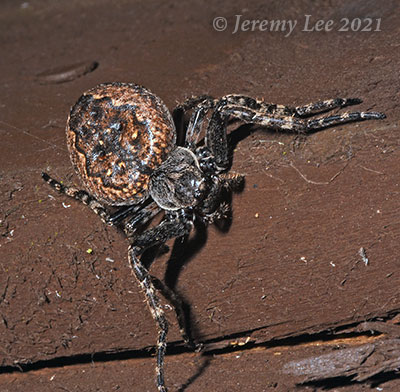
 |
|
Scientific Classifications explained » Amphibians » Ants » Aphids » Bees » Beetles » Birds » Bugs » Butterflies » Caterpillars » Damselflies » Dragonflies » Earwigs » Flies » Frog/Leafhoppers » Fungi » Galls » Grasshoppers » Harvestmen » Hoverflies » Lacewings » Ladybirds » Leaf Mines » Lichens » Mammals » Millipedes » Mosses » Moths » Sawflies » Slugs » Snails » Spiders » Trees & Shrubs » Wasps » Wild Flowers » Woodlice » Postboxes |
UK Nature > Spiders > Nuctenea umbratica

Scientific Name: Nuctenea umbratica Common Name: Walnut Orb Weaver The females of Nuctenea umbratica, or the Walnut Orb Weaver, can grow to 15 mm, males to 11 mm. They have a distinctive flattened body, which enable the species to hide in crevices. The walnut colouration of the abdomen gives the species its common name. The darker central portion with zig-zag edges is also typical of the species and means it can be easily identified from a photograph. It hides away during the day in nooks and crannies or under bark, close to its web and it only emerges to secure any prey that gets trapped in the web. Females of this species can be found all year round, whilst the males are usually seen in summer. After dark, it will emerge to construct a new web each evening and can then be seen sitting at the centre of its web waiting for its next meal. Common and widespread in Britain. |
|

https://www.uknature.co.uk is a website dedicated to showing the immense diversity of UK nature and wildlife. Our vast range of habitats, from lowland arable to snow covered mountains, from storm-ravaged coastlines to peaceful inland freshwater lakes and rivers, from dry, sandy heaths to deciduous and coniferous forests, all these habitats contribute to the abundance of UK nature. We have wild birds in huge numbers either residing or visiting our shores (597 recorded species as at July 2013) and we must also not forget the humble back garden with its grass lawns, flower beds filled with nectar rich flowers, shrubs and trees, all designed to attract huge numbers of insects such as bees, moths, butterflies and hoverflies; and finally the small ponds which provide safe havens for frogs, toads, newts and even slow worms and grass snakes. www.uknature.co.uk is the showcase for my personal passion, photographing uknature in all its glory. I sincerely hope you all enjoy the fruits of my labours. This site and all images contained therein is © Jeremy Lee 2004 - 2025. All Rights Reserved. Site design by Jeremy Lee. Site development & IT Support by Stuart Lee. |